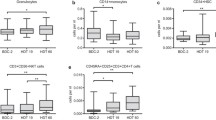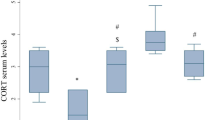Abstract
Prolonged inactivity is known to induce changes in responses of many physiological defense systems such as the hypothalamo-hypophyseal-adrenocortical axis, the sympathetic nervous system, and immuno-responsive systems. However, effects of various types of inactivity on immuno-responsive systems are still unknown. Therefore, the effects of two types of inactivity (immobilization: IMM and whole body suspension: WBS) on the number of white blood cells were studied in rats. Rats were divided into the control group and each inactivity group to compare the number of total white blood cells, lymphocytes, monocyte, neutrophil, eosinophil, and basophil during the experimental periods. Both IMM and WBS were maintained for 11 days. IMM markedly increased the number of total white blood cells, monocyte, neutrophil, and eosinophil in the 1st to 10th day. However, the number of total white blood cells, monocyte, neutrophil, and eosinophil during the experiment of WBS were characterized by the presence of a lag phase followed by the significant increased actions. IMM did not change the number of basophil during the experimental period. However, WBS increased the number of basophil in the 1st to 8th day to 2.8–4.8 times, compared with the values of the control. Both IMM and WBS did not change the number of lymphocytes. From these results, WBS increases the number of natural immunity cells without changing acquired immunity cells, and there are different responses in the number of total white blood cells, monocyte, neutrophil, eosinophil, and basophil between IMM and WBS.






Similar content being viewed by others
References
Anonymous (2002) Current issues and forthcoming events. J Adv Nurs 39:517–520
Åstrand P-O (1992) Why exercise? Med Sci Sports Exerc 24:153–162
Bishop CR, Athens JW, Boggs DR, Warner HR, Cartwright GE, Wintrobe MM (1968) Leukokinetic studies, 13: a non-steady-state kinetic evaluation of the mechanism of cortisone-induced granulocytosis. J Clin Invest 47:249–260
Booth FW, Gordon SE, Carlson CJ, Hamilton MT (2000) Waging war on modern chronic diseases: primary prevention through exercise biology. J Appl Physiol 88:774–787
Cioca DP, Watanabe N, Isobe M (2000) Apoptosis of peripheral blood lymphocyte is induced by catecholamines. Jpn Heart J 41:385–399
Colotta F, Re F, Polentarutti N, Sozzani S, Mantovani A (1992) Modulation of granulocyte survival and programmed cell death by cytokines and bacterial products. Blood 80:2012–2020
Cox G (1995) Glucocorticoid treatment inhibits apoptosis in human neutrophils. J Immunol 154:4719–4725
Dale DC, Fauci AS, Wolff SM (1974) Alternative-day prednisone: leukocyte kinetics and susceptibility to infections. N Engl J Med 291:1154–1158
Harada S, Tachiyashiki K, Imaizumi K (1998) Effects of sex hormones on rat liver cytosolic alcohol dehydrogenase activity. J Nutr Sci Vitaminol 44:625–639
Hayase K, Yokogoshi H (1991) Effect of suspension hypokinesia/hypodynamia on tissue protein turnover in rats. Jpn J Physiol 41:473–482
Hoffman C, Rice D, Sung H-Y (1996) Persons with chronic conditions. J Am Med Assoc 276:1473–1479
Imaizumi K, Tachiyashiki K (1994) Analysis of the growth hormone of rat hindlimb skeletal muscles on the basis of DNA, RNA and protein levels. Adv Exerc Sports Physiol 1:25–32
Imaizumi K, Tachiyashiki K, Jikihara K (1996) Responses of visceral organ size and skeletal muscle mass during whole body suspension and recovery in rats. Adv Exerc Sports Physiol 2:19–29
LaPerriere A, Ironson G, Antoni MH, Schneiderman N, Klimas N, Fletcher MA (1994) Exercise and psychoneuroimmunology. Med Sci Sports Exerc 26:182–190
Lopez AF, Williamson DJ, Gamble JR, Begley CG, Harlan JM, Klebanoff SJ, Waltersdorph A, Wong G, Clark SC, Vadas MA (1986) Recombinant human granulocyte-macrophage colony-stimulating factor stimulates in vitro mature human neutrophil and eosinophil function, surface receptor expression, and survival. J Clin Invest 78:1220–1228
Madden KS, Felten DL (1995) Experimental basis for neural–immune interactions. Physiol Rev 75:77–106
Mcconkey DJ, Orrenius S, Jondal M (1990) Agents that elevate cAMP stimulate DNA fragmentation in thymocytes. J Immunol 145:1227–1230
McFarlin BK, Mitchell JB, McFarlin MA, Steinhoff GM (2003) Repeated endurance exercise affects leukocyte number but not NK cell activity. Med Sci Sports Exerc 35:1130–1138
Miller ES, Koebel DA, Davis SA, Klein JB, McLeish KR, Goldwater D, Sonnenfeld G (1994) Influence of suspension on the oxidative burst by rat neutrophils. J Appl Physiol 76:387–390
Miyamoto N, Kanda K, Kawano S, Tamura Y, Murata Y, Ohmori S, Seo H, Matsui N (1992) Changes in urinary excretion of stress hormones in tail-suspended rats. In: Proceedings of the 10th space utilization symposium, Tokyo, pp 170–173
Morey-Holten E, Wronski TJ (1981) Animal models for stimulating weightlessness. Physiologist 24(Suppl 6):S45–S48
Musacchia XJ, Deavers DR, Meininger GA, Davis TP (1980) A model for hypokinesia: effects on muscle atrophy in the rat. J Appl Physiol 48:479–486
Nieman DC, Berk LS, Simpson-Westerberg M, Arabatzis K, Youngberg S, Tan SA, Lee JW, Eby WC (1989) Effects of long-endurance running on immune system parameters and lymphocyte function in experienced marathoners. Int J Sports Med 10:317–323
Nittoh T, Fujimori H, Kozumi Y, Ishihara K, Mue S, Ohuchi K (1998) Effects of glucocorticoids on apoptosis of infiltrated eosinophils and neutrophils in rats. Eur J Phamacol 351:73–81
Owen WF Jr, Rothenberg ME, Silberstein DS, Gasson JC, Stevens RL, Austen KF, Soberman RJ (1987) Regulation of human eosinophil viability, density, and function by granulocyte/macrophage colony-stimulating factor in the presence of 3T3 fibroblasts. J Exp Med 166:129–141
Ronsen O, Pedersen BK, Øritsland TR, Bahr R, Kjeldsen-Kragh J (2001) Leukocyte count and lymphocyte responsiveness associated with repeated bouts of strenuous endurance exercise. J Appl Physiol 91:425–434
Rothenberg ME, Owen WF Jr, Silberstein DS, Woods J, Sobermann RJ, Austen KF, Stevens RL (1988) Human eosinophils have prolonged survival, enhanced functional properties, and become hypodense when exposed to human interleukin-3. J Clin Invest 81:1986–1992
Rothenberg ME, Petersen J, Stevens RL, Silberstein DS, Mckenzie DT, Austen KF, Owen WF Jr (1989) IL-5-dependent conversion of normodense human eosinophils to the hypodense phenotype uses 3T3 fibroblasts for enhanced viability, accelerated hypodensity, and sustained antibody-dependent cytotoxicity. J Immunol 143:2311–2316
Steffen JM, Musacchia XJ (1987) Disuse atrophy, plasma corticosterone, and muscle glucocorticoid levels. Aviat Space Environ Med 58:996–1000
Suzuki K, Sato H, Kikuchi T, Abe T, Nakaji S, Sugawara K, Totsuka M, Sato K, Yamaya K (1996) Capacity of circulating neutrophils to produce reactive oxygen species after exhaustive exercise. J Appl Physiol 81:1213–1222
Suzuki K, Nakaji S, Yamada M, Liu Q, Kurakake S, Okamura N, Kumae T, Umeda T, Sugawara K (2003) Impact of a competitive marathon race on systemic cytokine and neutrophil responses. Med Sci Sports Exerc 35:348–355
Tarcic N, Ovadia H, Weiss DW, Weidenfeld J (1998) Restraint stress-induced thymic involution and cell apoptosis are dependent on endogenous glucocorticoids. J Neuroimmunol 82:40–46
The Physiological Society of Japan (2004) Guiding principle for the care and use of animals in the field of physiological sciences. Jpn J Physiol 54:98
Thomason DB, Booth FW (1990) Atrophy of the soleus muscle by hindlimb unweighting. J Appl Physiol 68:1–12
Valerius T, Repp R, Kalden JR, Platzer E (1990) Effects of IFN on human eosinophils in comparison with other cytokines: a novel class of eosinophil activators with delayed onset of action. J Immunol 145:2950–2958
van Furth R, Cohn ZA (1968) The origin and kinetics of mononuclear phagocytes. J Exp Med 128:415–435
van Furth R, Sluiter W (1986) Distribution of blood monocytes between a marginating and a circulating pool. J Exp Med 163:474–479
Wallen N, Kita H, Weiler D, Gleich GJ (1991) Glucocorticoids inhibit cytokine-mediated eosinophil survival. J Immunol 147:3490–3495
Yoshimura C, Miyamasu M, Nagase H, Iikura M, Yamaguchi M, Kawanami O, Morita Y, Iwata T, Yamamoto K, Hirai K (2001) Glucocorticoids induce basophil apoptosis. J Allergy Clin Immunol 108:215–220
Zahorec R (2001) Ratio of neutrophil to lymphocyte counts—rapid and simple parameter of systemic inflammation and stress in critically ill. Bratisl Lek Listy 102:5–14
Acknowledgments
We are grateful to Dr. Takashi Ichinose, Dr. Sachiko Nomura, Ms. Yuko Suzuki, Yuriko Higashino, Takashi Wada, and Yu Kawashima (Faculty of Human Sciences, Waseda University) for their good cooperation and helpful supports. Thanks are also due to Dr. Katsuhiko Suzuki for his advice and suggestions. This study was supported by a Grant-in-Aid for the Academic Frontier Project of the Ministry of Education, Culture, Sports, Science and Technology.
Author information
Authors and Affiliations
Corresponding author
Rights and permissions
About this article
Cite this article
Shirato, K., Motohashi, N., Tanihata, J. et al. Effects of two types of inactivity on the number of white blood cells in rats. Eur J Appl Physiol 98, 590–600 (2006). https://doi.org/10.1007/s00421-006-0306-6
Accepted:
Published:
Issue Date:
DOI: https://doi.org/10.1007/s00421-006-0306-6




